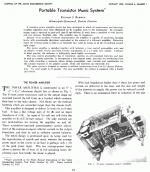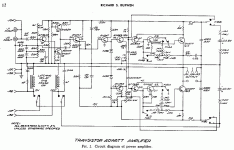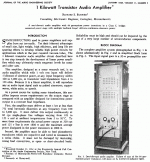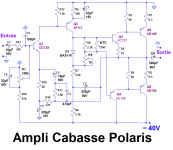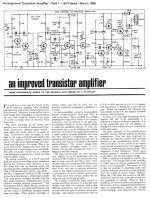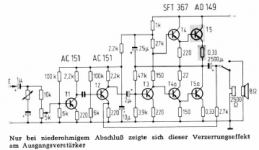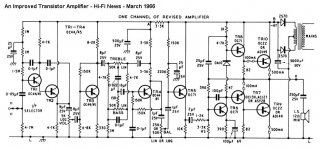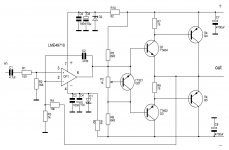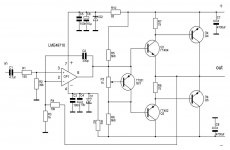page 86:
_https://worldradiohistory.com/Archive-Electronics/50s/Electronics-1959-05-29.pdf
_http://www.one-electron.com/Archives/RCA/RCA-LB/LB-1082%20RCA%20Labs%201957%20High-Power%20Transistor%20Audio%20Amplifiers.pdf
page 930:
http://www.introni.it/pdf/Costruire diverte 1967_12.pdf
_https://worldradiohistory.com/Archive-Electronics/50s/Electronics-1959-05-29.pdf
_http://www.one-electron.com/Archives/RCA/RCA-LB/LB-1082%20RCA%20Labs%201957%20High-Power%20Transistor%20Audio%20Amplifiers.pdf
page 930:
http://www.introni.it/pdf/Costruire diverte 1967_12.pdf
When I started, Ge was the only kind we could afford.
The early 1960s General Electric Transistor Manual has good examples.
Simply Googling your thread Topic brings up some stuff. more if you flip into "Images".
High power Germanium power amplifier - Google Search
I disagree. Google did not really help me in this regard. Pay closer attention to the schematics you realise 70% of them arent even GE transistor ones, and the few actual germanium ones are low power amplifiers.
Sorry but no, not here.
First you would need **germanium** diodes or at least a Germanium transistor as thermal sensor bu............................where diodes were not. (thermistors are bidirectional while diodes are not).
I agree why reinvent the wheel when you only need one...well the parts to make the wheel are basically dieing out. I just want to know if using silicon transistors (PNP and NPN) to drive the output finals germanium transistors would be reallistic. I am not looking specifficaly for extreme retro accuracy. Just want to hear the thing work.
My worry now is the biasing of the finals. With using germanium finals and silicon drivers I have no idea how it would behave at all..
The output stage topology is similar to JLH1969...
I don't see it.
...the few actual germanium ones are low power amplifiers.
OK.
Attachments
-Don't worry...Just want to hear the thing work.
-Alloy germanium transistors do not work well at frequencies above 5-10 kHz.
My worry now is the biasing of the finals. With using germanium finals and silicon drivers I have no idea how it would behave at all..
Problem is available circuits which you will find by googling or suggested by kind Forum members will have been designed "way back then" and generally use *all* germanium transistors, including drivers, because that´s what was available.I just want to know if using silicon transistors (PNP and NPN) to drive the output finals germanium transistors would be reallistic.
My worry now is the biasing of the finals. With using germanium finals and silicon drivers I have no idea how it would behave at all..
And later circuits were designed around silicon, period.
So I doubt you will find circuits mixing both.
One option is to use a driver transformer.
More practical than you think because old Beatles era VOX amplifiers were built that way, are still popular (thanks to Beatles association) , so much so that fresh made driver transformers are being offered, and winding data is freely available, go figure.
No complementary driver transistors and all others can be Silicon, the transformer keeps both Worlds separate.
Materials are cheap, you can recycle a small power transformer, and can wind and finish it in a single afternoon.
http://www.geofex.com/Article_Folders/Thomas Vox/Vox Driver Transformer.pdf
Original amps were unreliable because heatsinking was just a small piece of thin aluminum sheet, but using a real finned heavier one changes everything.
Lots of improvement tips here:
Thomas Vox Solid State Amps
Are these amps good?
Well, they were good enough for The Beatles.
In any case, if you want modern amp performance, just build one
Sorry, no Germaniums
R. G. Keen has done a HUGE work keeping these old workhorses alive, in his GeoFex site.
That´s a weird amplifier, so I don´t consider it an example....circuits mixing both.-The upper (first) diagram of #20)))
It´s a Class A only topology, no way to make a similar Class AB one, both power transistors are on completely separate circuits, top one is driven like on 99.9% of amplifiers and is DC coupled, also allows for DC feedback to stabilize output idle voltage, while bottom one behaves like a "modulated current source" for lack of a better definition, is AC coupled , has its own gain, only by chance supplies a signal roughly matching the one from upper half so is unsymmetrical by definition and NFB is needed to more or less match contribution from both output transistors.
It´s not biased in the conventional sense , only its idle current is set sort of hit and miss, having Silicon drivers is the least of its problems, a kludge if I ever saw one, so I can´t honestly recommend it.
A REAL design is the *second* amplifier posted by kokorianz in the same answer, and of course uses Germanium drivers and Thermistor biasing.
THAT is an example of a good "way back then" design and a model for many popular ones back in the day.
The first one .... ugh! ...
Asymmetric scheme: phase splitter (as JLH1969), loaded on Shiklai (Si npn and Ge pnp). The lower arm has an isolation capacitor at the input, which allows it to work in the AB class. Current offset from stabilized circuit. You can set the quiescent current for class A)))
The scheme was used in Germany in the 70s.
He did in 1973 on germanium transistors included Darlington. The sound is pleasant compared to Lin)))
The scheme was used in Germany in the 70s.
He did in 1973 on germanium transistors included Darlington. The sound is pleasant compared to Lin)))
Attachments
Problem is available circuits which you will find by googling or suggested by kind Forum members will have been designed "way back then" and generally use *all* germanium transistors, including drivers, because that´s what was available.
And later circuits were designed around silicon, period.
So I doubt you will find circuits mixing both.
One option is to use a driver transformer.
More practical than you think because old Beatles era VOX amplifiers were built that way, are still popular (thanks to Beatles association) , so much so that fresh made driver transformers are being offered, and winding data is freely available, go figure.
No complementary driver transistors and all others can be Silicon, the transformer keeps both Worlds separate.
Materials are cheap, you can recycle a small power transformer, and can wind and finish it in a single afternoon.
http://www.geofex.com/Article_Folders/Thomas Vox/Vox Driver Transformer.pdf
Original amps were unreliable because heatsinking was just a small piece of thin aluminum sheet, but using a real finned heavier one changes everything.
Lots of improvement tips here:
Thomas Vox Solid State Amps
Are these amps good?
Well, they were good enough for The Beatles.
In any case, if you want modern amp performance, just build one
Sorry, no Germaniums
R. G. Keen has done a HUGE work keeping these old workhorses alive, in his GeoFex site.
Thanks I will take a look. I have to admit I am bit inactive due to the lack of time I have. I dont expect the germaniums to sound like a 1970-90s AB amplifier
I want to stay away from drive transformers. Personal thing no big deal, I will look into that anyways. If I were to go with the drive transformer route I think A even more powerfull method would be with a output transformer just like a tube output.. Might hook my class mates guitar on it but I dont want a guitar amplifier. Just as a maybe.
I only need to solve the output section otherwise I can build up the thing. I have absolutely 0 experience with germaniums so the advice the people contributing give is very usefull.
- Status
- This old topic is closed. If you want to reopen this topic, contact a moderator using the "Report Post" button.
- Home
- Amplifiers
- Solid State
- High power Germanium power amplifier (any thoughts??)
